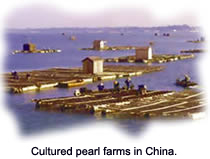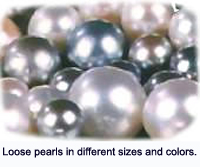Pearl Buyer's Guide
Pearls are
one of the unique gemstones on earth that come from a living
creature. For centuries, they are treasured by men and women
as gems that reflect royalty, power, love, purity, and
wealth. Nowadays, cultured pearls make pearl jewelry more
affordable to ordinary people. They make great gifts that
can bring lasting memories for women of all ages. Pearls are
timeless presents for birthdays, anniversaries, graduations,
Mother's Day, Valentine's Day, Christmas, and other special
occasions. Pearl jewelry also serves as beautiful bridal
fashion accessories for weddings. Pearls are also affordable
enough to be used as gifts for bridesmaids.
In order
to have our customers make informed decisions when buying
pearls from us, we have put together answers to the 7 most
commonly asked questions by our customers over time.
1. Are these pearls natural, cultured,
or imitation?
2. What are the types
of cultured pearls and their values?
3. How to determine
the quality of the pearls?
4. Is there a
grading system existed for pearl jewelry?
5. What size should I
buy?
6.
What
length of a pearl necklace should I buy?
7. What OVERTONE COLOR
of pearl should I choose?
1.
Are these pearls natural, cultured, or imitation?
Princess
Pearl carries only genuine cultured pearls. Fine cultured
pearls are the most popular pearls today and what you see
when you go to any retail jewelry store. Natural pearls are
extremely rare due to over fishing and pollution, thus a
pearl diver may dive a lifetime and only end up with a
handful of pearls, in which most will probably not be very
pretty.
 The difference between a natural pearl and a cultured pearl
is that natural pearls are a product of nature and cultured
pearls are a product of nature helped along by science. A
nucleus is implanted into the mollusk to stimulate nacre
production and over a few years nacre builds up layer by
layer ultimately creating the pearl. The nacre is the key
determiner in the pearls luster. Although the pearls are
cultured, this doesn’t mean they are all beautiful. In fact,
many are not, especially for the larger pearls which are in
the mollusk for a longer period of time and susceptible to
more adverse conditions. This is why larger round cultured
pearls are so rare. Natural pearls and cultured pearls are
produced in rivers, lakes, and seas or oceans by mollusks or
mussels. The difference between a natural pearl and a cultured pearl
is that natural pearls are a product of nature and cultured
pearls are a product of nature helped along by science. A
nucleus is implanted into the mollusk to stimulate nacre
production and over a few years nacre builds up layer by
layer ultimately creating the pearl. The nacre is the key
determiner in the pearls luster. Although the pearls are
cultured, this doesn’t mean they are all beautiful. In fact,
many are not, especially for the larger pearls which are in
the mollusk for a longer period of time and susceptible to
more adverse conditions. This is why larger round cultured
pearls are so rare. Natural pearls and cultured pearls are
produced in rivers, lakes, and seas or oceans by mollusks or
mussels.
Imitation pearls, also known as “faux”, “simulated,” and
“semi-cultured” pearls are not produced in a mollusk or
anything living for that matter. Many are glass, plastic, or
shell beads dipped in ground fish scales and lacquered with
pearl essence. It is easy to notice the difference when
placing them side by side with a cultured pearl. Cultured
pearls have an inner glow but imitation pearls only have a
surface shine. You can also use the “tooth test” to spot an
imitation pearl. If you run the pearl along the edge of your
upper teeth, the genuine cultured pearl will have a gritty
feel but the fake pearl will not. If you do a comparison on
cultured pearls and fake pearls, the difference is very
apparent.
2.
What are the types of cultured pearls and their values?
There are
four commonly recognized types of pearls: freshwater pearls,
Akoya saltwater pearls, Tahitian pearls and South Sea
pearls. Some jewelers refer to Tahitian pearls as South Sea
Tahitian pearls. Each type of pearl is produced by a
different species of mollusk, and each mollusk lives in a
different region on earth under very specific climatic
conditions.
Each type
of pearl has its own market value due to the supply and
demand relationship. South Sea and Tahitian pearls are the
most costly to be cultivated, they are rare, therefore,
their values are high. Akoya pearls are relatively easy and
less expensive to cultivate, the production volume is
higher, and the value of Akoya pearls is lower than South
Sea and Tahitian pearls.
Due to
the large over production of freshwater pearls by Chinese
farms, Freshwater pearls are the most inexpensive and
affordable cultured pearls among all its cultured pearl
family.
3. How to determine the quality of the
pearls?
 In
general, there are seven factors that determine the quality,
value, and beauty of pearls. They are luster, shape, color,
size, nacre quality, surface quality, and for pearl strands
or earrings, the matching of pearls. In
general, there are seven factors that determine the quality,
value, and beauty of pearls. They are luster, shape, color,
size, nacre quality, surface quality, and for pearl strands
or earrings, the matching of pearls.
Luster
– Luster is the
first and most important definition for a pearl’s beauty.
Luster should be your primary focus when judging quality. To
recognize finer luster, look at the clarity of images that
are reflected in the pearl’s surface. The closer to a mirror
image you see, the better the luster. Pearls with fine
luster also seem to glow warmly from within.
Shape
– Pearls exist in many shapes, such as round, near round,
pear or drop, button, coin, semi baroque, or baroque.
Generally speaking, the rounder a pearl, the rarer and more
valuable it is.
Size
– the larger the
pearl, the rarer it is. The size of a pearl is measured by
millimeters across its diameter. Different type of pearls
has a different range of sizes. For instance, South Sea
pearls are the largest and range from 8mm-18mm, Akoya pearls
range from 4mm-9mm.
Surface – the more flawless
the surface of a pearl is, the higher it will be valued.
However, a flawless pearl only comes about once in about
every million, as pearls are the result of a natural
process, and a mollusk will usually leave some sort of
unique mark on the finished pearl.
Color – unlike the other
factors, color has little influence on the actual value of a
pearl, except in the case of popularity. Essentially, the
color of the pearl you desire is a matter of personal taste.
Traditionally, there is a rather consistent demand for the
classic silvery white pearls and the glowing gold shades.
The rarest and most desired are the white “rose” colored
pearls.
Nacre Quality -
Nacre is
the natural substance that the mollusk secretes to protect
its sensitive flesh from irritants such as shell fragments
or implanted beads. This is the same beautiful iridescent
material that lines the inner surface of the oyster shells,
aptly named mother-of-pearl. As a rule, the thicker the
nacre, the higher quality the pearl is.
Matching
– For a piece of pearl jewelry that consists of more than
one pearl, such as a strand of necklace, or a pair of
earring, matching of pearls becomes another important factor
to determine the value of the jewelry. Look at the size,
shape, color, luster and surface of the
pearls to see if they matched very well. A perfectly matched
pearl necklace or earrings will ultimate enhance the value
of the piece.
4. Is there a grading system existed
for pearl jewelry?
There is
not an industry-wide grading system for pearls. However, as
most pearl companies, Princess Pearl uses the A, AA, AAA
system to grade its cultured pearls on overall quality. On
this scale, AAA is gem-quality, the highest quality cultured
pearl available.
5. What size should I buy?
The
perfectly size of pearl for a lady to wear is largely
influenced by her age, height, and build.
For
instance,
If the lady is 40 years
old, the bigger size higher quality pearls are the more
appropriate choice. For a younger lady, smaller pearls in
medium quality range would be a perfect match.
A woman's height is very important when choosing the
pearl size and pearl length. Taller women will look terrific
in larger pearls and longer necklace lengths; shorter women
will look lovely in smaller pearl sizes and shorter necklace
lengths. Also, build has a great impact on the perfect
pearls for her. If she is petite then smaller pearl size
would be perfect for her, along with shorter necklace
length. If she is average build then larger pearls in longer
lengths would accentuate her beauty.
6.
What length of a pearl necklace should I buy?
Choosing the right length is an important part of your
purchase. Here are some ideas of what might be the right
length for her.
Choker - 16 inches.
A pearl choker is perhaps the most classic and yet versatile
of all the single strand lengths. A simple pearl choker can
go with virtually any outfit from casual to fancy evening
wear, and just about any neckline imaginable.
Princess - 18 inches.
The princess length necklace is best suited for crew and
high necklines. It also complements low plunging necklines.
Matinee - 20 to 24 inches.
Longer than the choker, and just a bit shorter than an opera
length, the matinee necklace is the right choice for casual
or business dressing. HINT: When buying for an older
woman, a longer length helps to draw the attention away from
the neck and to the pearls.
Opera - 28 to 36 inches.
The opera necklace is the queen of all the lengths. When
worn as a single strand, it is refined and perfect for high
or crew necklines. When doubled upon itself, it serves as a
versatile two strand choker.
7.
What
OVERTONE COLOR
of pearl should I choose?
The overtone color of a pearl is a subtle, translucent color
that lies across a pearl’s surface and is secondary to the
body color.
Having no overtone color is always a safe choice unless you
know what overtone color the person you are buying for
prefers.
Helpful Hints:
A woman with very fair skin may prefer a slight rose
overtone since it will add color to their appearance. A
woman with darker skin color or graying hair will sometimes
prefer more of a silver overtone.
|